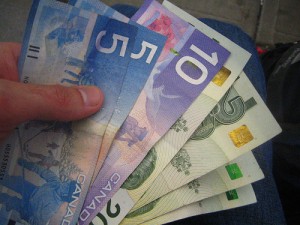Currency
 (©rick, flickr.com) (©rick, flickr.com)Colourful Canadian money is used in Nova Scotia |
Nova Scotia’s currency is the Canadian Dollar and all prices on this site are in Canadian Dollars or bucks – a slang term for dollars.
The most common banknotes you’re likely to get from a bank or ATM machine are $5, $10 and $20 bills.
You can also see notes of $50 and $100 but small shops may not have enough change if you try to pay for a small purchase with them.
If you spend any time at all in Nova Scotia, you’ll certainly find yourself with a pocketful cents (indicated by the ¢ symbol) in the form of 1¢, 5¢, 10¢, 25¢, $1 and $2 coins. Canadians have a number of special names for their coins.
The 1¢ coin is the smallest form of Canadian currency, making up 1/100th of a dollar. It’s called a penny. Despite its copper colour, it’s made mostly of steel.
The 5¢ coin has a beaver on one face and is called a nickel because from the 1920s to the 1940s it was made mostly of nickel. Today steel is the primary metal. It’s worth 1/20th of a dollar.
The 10¢ coin is called a dime and is the smallest Canadian coin, worth 1/10th of a dollar. Nova Scotia’s legendary Bluenose Schooner is featured on one side.
The 25¢ coin is called a quarter and you’ll use it a lot, for everything from payphones to vending machines. Quarters with many different designs and even colours are issued but the traditional design features a caribou. As the name suggests, it’s worth 1/4 of a dollar.
The $1 coin is heavy and, along with its counterpart the $2 coin, it will quickly make your pockets sag. Canadians dubbed the $1 coin a Loonie when it was first minted in 1987. When the $2 coin emerged in 1996, the nickname Toonie or Twonie was adopted.